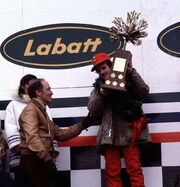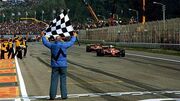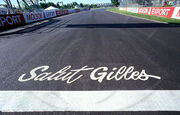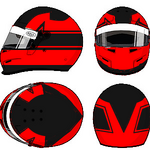Joseph Gilles Henri Villeneuve (DJILL VILL-nerve; born 18 January 1950 in Saint-Jean-sur-Richelieu, Montérégie, Quebec, Canada – died 8 May 1982 in Leuven, Flemish Brabant, Flemish Region, Belgium) was a Canadian racing driver who most notably drove for Ferrari in Formula One.
Villeneuve started his racing career in snowmobile racing, before moving into single-seater cars, winning the Formula Atlantic Championship in 1976. He drove a solitary race for McLaren as a third driver in 1977 before moving to Ferrari, also as a third driver, with whom he drove the final two races of the season after World Champion Niki Lauda choose to sit out the final two races of the season.
Villeneuve won his first race at the end of the 1978 season, at his home race. Villeneuve continued in 1979 strongly, winning three races and taking four second places to finish the championship second behind teammate Jody Scheckter.
After a disappointing 1980 and an up-and-down 1981 (in which Villeneuve took two victories), Villeneuve started the 1982 in a car capable of challenging for the title on terms of both speed and reliability. After an altercation with Didier Pironi at the boycott-affected San Marino Grand Prix, in which he vowed to never speak to his French teammate again, Villeneuve was fatally injured in an accident with Jochen Mass in qualifying for the Belgian Grand Prix at the age of 32.
Gilles' younger brother, Jacques, competed in F1 without any success. In 1996, his son, also called Jacques, began his Formula One career, during which he became the only Canadian to win the Formula One World Championship in 1997.
In his legacy, the circuit in Montreal was named after him and the number 27 Ferrari car is still associated with him.
Formula One Career[]
Pre-Formula One[]
Villeneuve began his racing career when racing his personal car in drag-racing competitions. He eventually earned a racing license at the Jim Russell Racing School at Le Circuit Mont Tremblant. He then began racing a very successful season in Formula Ford with a car he had purchased. He managed to win seven of the ten races he entered.
After only a season of Formula Ford, he advanced to the higher Formula Atlantic series where he raced for four years. Because of his popularity in snowmobile racing, he was able to gain a sponsor for his second year of Formula Atlantic from the snowmobile company, Skiroule.
"Every winter, you would reckon on three or four big spills—and I'm talking about being thrown on to the ice at 100 miles per hour. Those things used to slide a lot, which taught me a great deal about control. And the visibility was terrible! Unless you were leading, you could see nothing, with all the snow blowing about. Good for the reactions—and it stopped me having any worries about racing in the rain."
Continuing his Formula Atlantic career, he raced against many Formula One legends such as James Hunt, who would eventually help Villeneuve to move to Formula One.
1977[]
After beating James Hunt and other legendary drivers in a Formula Atlantic race, Villeneuve was offered a position on the McLaren Racing Team as a third driver. Villeneuve did not race until the tenth race of the 1977 season, the British Grand Prix. He qualified in ninth position on the grid and finished the race in eleventh place, after a temperature gauge malfunction that put him two laps down.
This was Villeneuve's only race with the McLaren team as they decided not to renew his contract for the upcoming season. After being released from McLaren, Villeneuve signed with Ferrari for the final two races of the 1977 season. Villeneuve would spend the remainder of his racing career with team Ferrari.

During the last two races of the 1977 season, Villeneuve served as a substitute for Niki Lauda. He finished twelfth in his first Canadian Grand Prix, but was taken out of the Japanese Grand Prix after being involved in an accident with Ronnie Peterson on lap five, killing a spectator and track safety marshal.
1978[]
"If someone said to me that you can have three wishes; my first would have been to get into racing, my second to be in Formula One, my third to drive for Ferrari..."

Gilles Villeneuve holding his trophy after winning the 1978 Canadian Grand Prix.
Gilles Villeneuve's dream came true as he secured a ride with Ferrari for the 1978 season.
During the 1978 season, Villeneuve experienced many issues with the new Michelin tyres that contributed to six race retirements throughout the year. This led to pressure from the media for Ferrari to replace Villeneuve, but this did not happen.
At the final race of the season, Villeneuve qualified third in front of his home crowd at the Canadian Grand Prix at the then-named Circuit Île Notre-Dame. After leader Jean-Pierre Jabouille retired, to the delight of the fans, Villeneuve took the lead and won his home race for what turned out to be the only time in his career. Many say that this win was the highlight of his entire career in Formula One.
1979[]

Gilles Villenueve VS Rene Arnoux
Gilles Villenueve and Rene Arnoux battling for second position in the 1979 French Grand Prix
In the 1979 season, Villeneuve was joined by his new teammate, Jody Scheckter, who was replacing Carlos Reutemann.
Villeneuve went on to win three races that season. The most memorable race of the season was the French Grand Prix when Villeneuve and Renault's René Arnoux battled for second position in the closing laps of the race. Villeneuve managed to beat the Frenchman after drifting and locking his tyres on multiple turns and even making contact at one point. This was the race of the season and is still known as one of the greatest battles in Formula One history.
"That is my best memory of Grand Prix racing. Those few laps were just so fantastic to me - out-braking each other and trying to race for the line, touching each other but without wanting to put the other car out. It was just these two guys battling for second place without trying to be dirty but having to touch because of wanting to be first. I loved that moment."
At the end of the season, Villeneuve missed out on being World Champion by four points. Ferrari finished first and second in the championship points with Scheckter as the World Champion.
1980[]
Ferrari experienced its worst year in its history during the 1980 season. The team's car lacked the down force and grip provided from the ground effect that other teams had.
Villeneuve did not finish six out of the fourteen races in the season and only earned six championship points, while his teammate, Jody Scheckter only earned two points and would then retire at the end of the season.
1981[]
In the 1981 season, Ferrari released their first turbo engine car. Although the car was fast, it still lacked much of the down force and handling abilities that the other teams had.
"That car...had literally one quarter of the downforce that, say Williams or Brabham had. It had a power advantage over the Cosworths for sure, but it also had massive throttle lag at that time. In terms of sheer ability I think Gilles was on a different plane to the other drivers. To win those races, the 1981 GPs at Monaco and Jarama—on tight circuits—was quite out of this world. I know how bad that car was."
Ferrari hired Didier Pironi as Villeneuve's new teammate for the season.
The 1981 Spanish Grand Prix would be Villeneuve's last victory and the second closest finish in Formula One history, with a lead of 0.22 seconds over Jacques Laffite. Villeneuve finished the season in 7th place with 25 points after facing 8 retirements and a disqualification from the Caesars Palace Grand Prix for an incorrect start.
1982[]

Didier Pironi wins after overtaking Gilles Villeneuve on the last lap of the 1982 San Marino Grand Prix.
The 1982 season was followed by two retirements and a disqualification from the United States Grand Prix West for an illegal rear wing on the car.
Villeneuve's teammate also became his rival at the San Marino Grand Prix when the teammate overtook him on the last lap of the race, despite orders from the team to hold position. Villeneuve was angry and claimed that he would never talk to Pironi again. But Pironi himself believed that he had done nothing wrong because the team only ordered for the cars to slow down to save gas, and did not request for him to hold position.
"I think it is well known that if I want someone to stay behind me and I am faster, then he stays behind me."
Ferrari would also face tragedy when Villeneuve was killed while qualifying for the Belgian Grand Prix.
Death[]
- See also: Death of Gilles Villeneuve
During a qualifying session for the 1982 Belgian Grand Prix, Villeneuve was killed with eight minutes remaining in the session.
While returning to the pits for a fresh set of tyres, Villeneuve was gaining on Jochen Mass, who was traveling at a much slower speed. To allow Villeneuve to overtake him, Mass moved to the right of the track, but Villeneuve was also traveling to the right for the overtake. Villeneuve struck the rear of Mass' car, sending the Ferrari airborne at a speed estimated to be faster than 200 km/h.
After being airborne for over 100 m, the car nosedived into the ground ejecting Villeneuve's seat from the car and into the catch fence. He was removed from the catch fence by fellow drivers John Watson and Derek Warwick. Medical staff arrived on scene within a minute of the accident and treated the breathless Canadian. He was taken to the track medical centre and airlifted to University St Raphael Hospital. He died of fatal neck fractures later that evening after being kept on life support for a number of hours.
Legacy[]

The Circuit Gilles Villeneuve start/finish line in 1983
The track hosting the Canadian Grand Prix, originally named the Île Notre-Dame Circuit was renamed the Circuit Gilles Villeneuve in memory of the Canadian racing legend. The message "Salut Gilles" can be found at the start/finish line of the circuit in his honor.
In 1993, Gilles Villeneuve was inducted into the Canadian Motorsport Hall Of Fame followed by the issuing of the Gilles Villeneuve Canadian postage stamp in 1997.
In the San Marino Grand Prix track Autodromo Enzo e Dino Ferrari (commonly known as Imola), the 5th and 6th turns have been named "Variante Villeneuve" in Villeneuve's honor. The third starting grid of the track also has a Canadian flag painted on the pavement, as well as a bronze bust of him at the entrance to the Ferrari test track.
At Zolder, the corner in which Villeneuve was killed was turned into a chicane turned named in his memory.
Helmet Design[]

Gilles Villeneuve's helmet design.
Gilles Villeneuve's helmet was black with a stylish red "V" in the rear of the helmet. This design was created with his wife.
Since his death, several drivers such as Christian Fittipaldi, Perry McCarthy, and his son Jacques have used the design with an alternate colour scheme. Jacques' helmet placed the "V" on the sides of the helmet, and instead of red and black used blue, pink, yellow, green and red and the base.
Formula One Statistical Overview[]
Formula One Record[]
| Year | Entrant | Team | WDC Points | WDC Pos. | Report |
|---|---|---|---|---|---|
| 1977 | Marlboro Team McLaren | McLaren-Ford Cosworth | 0 | NC | Report |
| Scuderia Ferrari SpA SEFAC | Ferrari | ||||
| 1978 | Scuderia Ferrari SpA SEFAC | Ferrari | 17 | 9th | Report |
| 1979 | Scuderia Ferrari SpA SEFAC | Ferrari | 47 (53) | 2nd | Report |
| 1980 | Scuderia Ferrari SpA SEFAC | Ferrari | 6 | 12th | Report |
| 1981 | Scuderia Ferrari SpA SEFAC | Ferrari | 25 | 7th | Report |
| 1982 | Scuderia Ferrari SpA SEFAC | Ferrari | 6 | 15th | Report |
Career Statistics[]
| Entries | 68 |
| Starts | 67 |
| Pole Positions | 2 |
| Sprint Poles | 0 |
| Front Row Starts | 8 |
| Race Wins | 6 |
| Sprint Wins | 0 |
| Podiums | 13 |
| Sprint Podiums | 0 |
| Fastest Laps | 8 |
| Sprint Fastest Laps | 0 |
| Points | 107 |
| Laps Raced | 3283 |
| Distance Raced | 15,194 km (9,441 mi) |
| Races Led | 18 |
| Laps Led | 534 |
| Distance Led | 2,251 km (1,399 mi) |
| Doubles | 1 |
| Hat-Tricks | 1 |
| Grand Chelems | 1 |
Race Wins[]
Career Results[]
| Complete Formula One Results | |||||||||||||||||||||||||
|---|---|---|---|---|---|---|---|---|---|---|---|---|---|---|---|---|---|---|---|---|---|---|---|---|---|
| Year | 1 | 2 | 3 | 4 | 5 | 6 | 7 | 8 | 9 | 10 | 11 | 12 | 13 | 14 | 15 | 16 | 17 | Pts | Pos | ||||||
| 1977 | 0 | NC | |||||||||||||||||||||||
| 11th | 12th | Ret | |||||||||||||||||||||||
| 1978 | 17 | 9th | |||||||||||||||||||||||
| 8th | Ret | Ret | Ret | Ret | 4th | 10th | 9th | 12th | Ret | 8th | 3rd | 6th | 7th | Ret | 1st | ||||||||||
| 1979 | 47 (53) | 2nd | |||||||||||||||||||||||
| Ret | 5th | 1st | 1st | 7th | 7th | Ret | C | 2nd | 14th | 8th | 2nd | Ret | 2nd | 2nd | 1st | ||||||||||
| 1980 | 6 | 12th | |||||||||||||||||||||||
| Ret | 16th | Ret | Ret | 6th | 5th | 8th | Ret | 6th | 8th | 7th | Ret | 5th | Ret | ||||||||||||
| 1981 | 25 | 7th | |||||||||||||||||||||||
| Ret | Ret | Ret | 7th | 4th | 1st | 1st | Ret | Ret | 10th | Ret | Ret | Ret | 3rd | DSQ | |||||||||||
| 1982 | 6 | 15th | |||||||||||||||||||||||
| Ret | Ret | DSQ | 2nd | DNS [1] |
|||||||||||||||||||||
| Key | |||||
|---|---|---|---|---|---|
| Symbol | Meaning | Symbol | Meaning | ||
| 1st | Winner | Ret | Retired | ||
| 2nd | Podium finish | DSQ | Disqualified | ||
| 3rd | DNQ | Did not qualify | |||
| 5th | Points finish | DNPQ | Did not pre-qualify | ||
| 14th | Non-points finish | TD | Test driver | ||
| Italics | Scored point(s) for Fastest Lap | DNS | Did not start | ||
| 18th† | Classified finish (retired with >90% race distance) | NC | Non-classified finish (<90% race distance) | ||
| 4thP | Qualified for pole position | [+] More Symbols | |||
Notes[]
- ↑ Fatal accident during a practice session
External links[]
- ESPN Driver Profile
- Circuit Gilles Villeneuve Official Website
- Canadian Motorsport Hall of Fame
- Canadian Motorsport Hall of Fame - Gilles Villeneuve
| V T E | ||
|---|---|---|
| Seasons 1977 • 1978 • 1979 • 1980 • 1981 • 1982 | ||
| Season Reports 1977 • 1978 • 1979 • 1980 • 1981 • 1982 | ||
| Teams McLaren (1977) • Ferrari (1977-1982) | ||
| Teammates James Hunt (1977) • Jochen Mass (1977) • Carlos Reutemann (1977-1978) • Jody Scheckter (1979-1980) • Didier Pironi (1981-1982) | ||
| Rivalries Pironi | ||
| Other pages Jacques (son) • Jacques (brother) • Death • Statistics • Teammate comparison • Category | ||
| v·d·e | Nominate this page for Featured Article |
